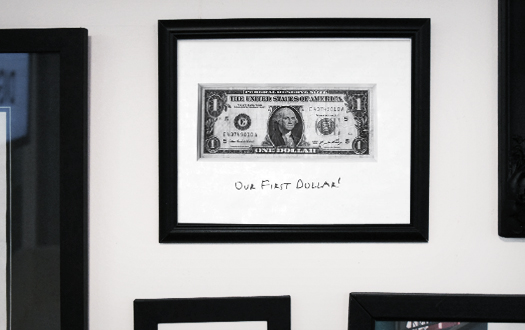By
DIGOWorkSection | 06/01/2012 | in

If you want to look at the downsides and limits of “market category thinking,” the slide rule category provides some excellent examples. Keuffel & Esser Corporation, a company founded in 1867 in Manhattan is a good place to start. In 1962, the company introduced it’s DECILON slide rule into the booming market for slide rules, and on the strength of this line was able to go public on NASDAQ in 1965. But by 1982, the firm was forced to declare chapter 11 bankruptcy. This same year, AZON corp buys ownership of K&E Trademarks and K&E is no more. [1]
ARISTO had over a century of slide rule production, but was forced to close in 1978. [2]
Sphere Research Corporation of British Columbia, Canada, runs a web page devoted to fans and collectors of slide rulers.
“In these company archives, you can find very detailed info about the rules and models they made, the company and its history. Some rule makers were in business almost 100 years, and their histories and products are fascinating. Some major makers still survive today, but without any help from slide rules, as their businesses are now quite different. In the 1960’s, the industry was at its most sophisticated, and there were large slide rule manufacturers all over the world, each with their unique styles and features. This industry and technology survives today mainly in the form of slide charts, and the hearts of collectors.”
By
DIGOWorkSection | 06/01/2012 | in

When I started my agency, I reached out to someone I had been working with to gage his interest in being my partner. At the time, he said he was intrigued, but was just not ready to make the leap.
I would have liked to start my business with a partner, to share the weight and to make the growing easier. But, I knew that partnership was like marriage, challenging even with the best match, so I decided to make a start as a sole proprietor
The first year felt like a decade – an exhilarating decade, and exciting decade, but also a stressful, challenging, dread-inducing decade during which I was either earning or losing roughly $70,000 per month with zero cushion for error. After all of this, my friend declared himself ready and admitted, “I didn’t think you would really do it. I had always thought that people who talk about things don’t do them and people who do things don’t talk about them. Obviously, I was wrong.” He proposed he’d join the business now with something like half of the equity.
The idea that people who talk about things don’t do them struck me as absurd. If I had to choose a cliché’, I would have chosen the one about snoozing and losing. I told my friend that the year I had invested and the risk I had taken to establish the agency had great value and that there was no way I could pretend otherwise and treat the situation as I might have a year earlier.
We decided to remain friends and I continued on my own.
By
DIGOWorkSection | 06/01/2012 | in

We can’t see the world as static. Conceptual boxes can be helpful as long as we realize we have invented them ourselves to help us understand things. The moment we forget that we can uninvent them, we’re stuck.
There is a tendency to view market categories as a given. We think we’re in the “server hardware” category. Or the fitness club category. Or the E-commerce category. Like Blackberry (Research In Motion) was in the smartphone category and Apple was in the personal computer category. Oops.
Or Starbucks was in the coffee shop category and McDonald’s was in the Fast Food category. If categories tell us which competitors to ignore and which competitors to track, than category thinking is dangerous. You won’t see them coming!
If category thinking limits your imagination about how to expand and grow your brand and business, then category thinking can be deadly
David Gardner of the The Motley Fool talks about “top dogs” and “first movers.” A first mover is a company with a new technology or system that completely changes an industry, disrupts the existing categories and creates a new one. Ebay in digital auctions. Amazon in online retailing. NetFlix in digital streaming of movies and TV shows. Better to be one of these, or follow one of these, then be the disturbee. For more inspiration, read about an industry that ruled the world:
When I was growing up, my Dad was an electrical engineer, working on his PhD and developing silicon chip technology. I fondly remember his slide rules and his easy comfort with calculating based on these pre-digital computers. The slide rule category was once a thriving global category and the 1960’s represented this two hundred year old industry’s peek. Curiously, even as digital computing was coming up, slide rule makers were enjoying a robust market. But all of that ended abruptly in 1974 when HP introduced the first inexpensive scientific calculator. Today only one Japanese company continues to manufacture slide rules.
By
DIGOWorkSection | 06/01/2012 | in

Intel founder, tech genius and billionaire Andy Grove titled his book, Only the Paranoid Survive.
Since we can’t see everything, the truth is that we make decisions based on our biases. Most of us don’t question our biases, they are just “the way we are.”
Grove developed a set of biases that propelled him to the top of the digital world. Where did he get them? Nazi Germany
To my mind, the reason Grove’s paranoia worked so well is that most people have the opposite bias. Blessed with good enough childhoods and with normally limited imaginations that protect them from the anxiety of seeing all the possibilities, most people deal with what they think they know.
Pearl Harbor. Nine-eleven. Sputnik. AIDS. Black Friday. Our tendency is to deal with things when we have to, rather than at the optimal time. Our tendency is to be surprised.
It’s good to know what you can about what competitors are doing. Like Starbucks looked at high-end coffee shops… and then McDonald’s came along…
The competition is always coming, but you just don’t know where it’s coming from. That’s the kind of paranoia that drives you to innovate, to stay ahead.
The Fountainhead: Why to do thought leadership and content marketing.
The Fountainhead: Why to do thought leadership and content marketing.
If you understand the value of the content you create to your audience, then you’ll have a much better idea of what’s worth doing and how to do it.
Let’s start with the current norm. Those of us who are doing this because we think thought leadership or content management is a good thing to be doing. We think we’re helping people make a product decision. Or we think we’re simply building the reputation of our company. And perhaps we also think we’re creating inexpensive ways to expand the potential for prospective customers to engage with us, and then perhaps be converted to customers down the line. Maybe we also think we’re arming our brand advocates with information and data they can use to advocate for us with others
Of course, these are all good reasons to build a content or thought leadership strategy. But they miss the essential element that makes all of this content so valuable: self-esteem.
Yes, many people seek out product information and knowledge about categories in order to build their own self-esteem. These segment into a few psychographic types. Some love the process in and of itself, many others are interested in the social status they derive for category knowledge, and even more are interested in the dopamine-mediated pain reduction that comes from encountering social-validation of a good decision they have already made.
If you know that the purpose of your ‘thought leadership’ is to make the decision process and lifecycle more gratifying and better, then you know a lot!
By
DIGOWorkSection | 06/01/2012 | in

If you understand the value of the content you create to your audience, then you’ll have a much better idea of what’s worth doing and how to do it.
Let’s start with the current norm. Those of us who are doing this because we think thought leadership or content management is a good thing to be doing. We think we’re helping people make a product decision. Or we think we’re simply building the reputation of our company. And perhaps we also think we’re creating inexpensive ways to expand the potential for prospective customers to engage with us, and then perhaps be converted to customers down the line. Maybe we also think we’re arming our brand advocates with information and data they can use to advocate for us with others
Of course, these are all good reasons to build a content or thought leadership strategy. But they miss the essential element that makes all of this content so valuable: self-esteem.
Yes, many people seek out product information and knowledge about categories in order to build their own self-esteem. These segment into a few psychographic types. Some love the process in and of itself, many others are interested in the social status they derive for category knowledge, and even more are interested in the dopamine-mediated pain reduction that comes from encountering social-validation of a good decision they have already made.
If you know that the purpose of your ‘thought leadership’ is to make the decision process and lifecycle more gratifying and better, then you know a lot!
By
DIGOWorkSection | 06/01/2012 | in

Upscale hotels leave a chocolate on your pillow. Tom Civitano was determined that The Plaza Hotel would never be a typical upscale hotel. His standard was “Legendary.”
The budget, however, would barely pay for chocolates. Tom’s idea: A Pearl!
He approached Mikimoto, the famous purveyor of the world’s finest pearls. He told the CEO of Mikimoto all about the Plaza Hotel’s clientele, including how much they were spending on jewelry
The Mikimoto brand simply had to have access to these potential customers! But, as Tom explained, it wouldn’t do to degrade the experience of Plaza guests with mercenary advertising such as brochures in their rooms. No, what was needed was an extraordinary gesture, a gift at once seductive and magical, a Pearl on the Pillow.
And it happened! Each time a guest stayed at The Plaza, he or she would find a new pearl, and a note with a $250 gift certificate and invitation to have the pearls strung into a necklace at Mikimoto.
Of course, the joint promotion was legendary and covered as a fairy tale come true in all media. And it worked wonders in driving revenue and loyalty for the hotel and new customers to Mikimoto.
By
DIGOWorkSection | 06/01/2012 | in
(NEW YORK – May 8, 2012) – Award-winning broker-dealer and futures commission merchant TradeStation, a wholly owned subsidiary of Monex Group, Inc. (TSE: 8698), today launched a new integrated marketing campaign, highlighting its award-winning platform. New York-based brand-building agency DiMassimo Goldstein (DIGO) created “The Proof is in the Platform” initiative, which will feature print, TV and digital advertising along with a strong social media component.
The ads lightly spoof TradeStation’s competitors, encouraging traders to focus on the actual capabilities of trading platforms. Print ads will begin running in Technical Analysis of Stocks & Commodities, Futures Magazine and Active Trader, and TV spots will begin airing on CNBC today.
“We don’t need bells, whistles or special effects to impress or attract traders,” said Erik Jepson, VP of Marketing for TradeStation, which received the highest overall ranking (4 ½ stars) from Barron’s magazine in its 2012 review of online brokers, as well as Best for Frequent Traders, Best Trading Experience and Technology, and Best for International Traders.
“Our platform speaks for itself, and speaks louder than flashy, over-the-top advertising does,” Jepson added.
That’s the reasoning behind TradeStation’s decision to create a tour of its platform features on TradeStation.com. Hosted by the TradeStation Guys, the tour, which debuts today, will allow traders to see firsthand how advanced TradeStation’s platform’s tools are through several one- to two-minute videos.
By
DIGOWorkSection | 06/01/2012 | in

Marketing Daily’s Karlene Lukovitz writes,
When you have a name like Double Cross Vodka, April Fool’s Day is just too good an opportunity to pass up.
The ultra-premium vodka brand — distilled in Slovakia and launched (at least originally) specifically for the U.S. market in September 2008 — will kick off its first official consumer campaign on April 1, premised on helping people “double-cross the mundane and frustrating moments of life.”
The campaign’s hub is a microsite, Projectdoublecross.com, where fans can pick up tips for turning the tables on annoying types like arm rest-hoggers, at-table texters, telemarketers and chatty urinal neighbors. In addition, visitors can post and share (through the brand’s Facebook or Twitter accounts) their own “double cross” ideas.
Examples: To double-cross a loud cell phone talker, stand directly in front of him/her, position your Double Cross martini to the side of your head as if it were a phone, and adopt the same tone/volume as the offending phone-talker as you actually respond to what he/she is saying. To double-cross a subway pole-hugger, put your face close to the pole and begin whispering seductively to it; then enjoy your newly created personal space. Read more…









